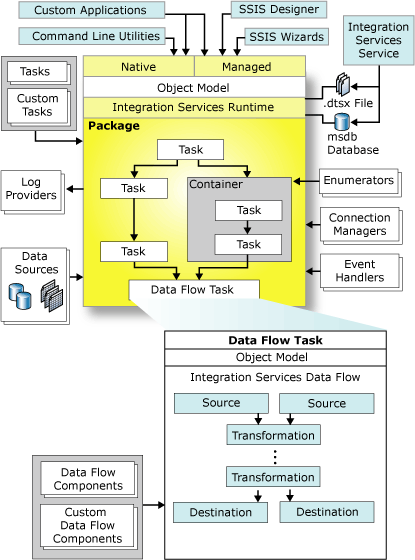SQL Server Integration Services (SSIS)
Overview
SQL Server Integration Services (SSIS) is Microsoft's Extract, Transform, Load ([[articles:Extract Transform Load (ETL)|ETL]]) tool and is provided with [[articles:SQL Server versions|SQL Server]]. SSIS provides a rich set of built-in tasks, containers, transformations, and data adapters that support the development of business applications. Without writing a single line of code, you can create SSIS solutions that solve complex business problems using ETL and business intelligence, manage SQL Server databases, and copy SQL Server objects between instances of SQL Server.
For an overview of the typical uses of SSIS, see Typical Uses of Integration Services.
For product installation, videos, and Books Online topics, see the SQL Server 2012 Resource Center.
For the latest downloads, articles, samples, and videos from Microsoft and the community, visit the Integration Services page on MSDN.
Architecture

This architecture diagram is true as at November 2009
The runtime environment of [[articles: SQL Server Integration Services|SSIS]] consists of 2 engines, the [[articles:SSIS Runtime Engine|Runtime Engine]] and the [[articles:SSIS Dataflow Engine|Dataflow Engine]]. A [[articles:SSIS Package|package]] consists of [[articles:SSIS Tasks|tasks]] (one of which is the all-important [[articles:SSIS Dataflow Task|Dataflow Task]]) and [[articles:SSIS Containers|containers]]. The development tool for SSIS is Business Intelligence Development Studio ([[articles:Business Intelligence Development Studio (BIDS)|BIDS]]). In SQL Server 2012, BIDS is replaced with SQL Server Data Tools for BI (SSDT-BI).
Community Resources
Connectivity
- Connecting to MySQL from SSIS
- Writing to a MySQL Database from SSIS
- SSIS Resources (Samples, books, tutorials ...)
- Optimized Bulk Loading of Data into Oracle
Upgrade and Migration
- SQL Server 2008 Migration White Papers (Informix, MySQL, Oracle, Sybase)
- 5 Tips for a Smooth SSIS Upgrade to SQL Server 2012
For a list of additional community resources, go to [[articles:SSIS Community Resources|SSIS Community Resources]].
For a list of design patterns, go to SSIS Design Patterns Wiki
SQL Server "Denali" CTP1 SSIS Wiki Pages
Migrate and Deploy SSIS Packages
- How to: Migrate and Deploy Projects to the Integration Services Server
- [[Project Deployment Overview in SQL Server "Denali" CTP1 - SSIS]]
Design SSIS Packages
SSIS Wiki Pages
- What's New in SSIS 2008 and 2008 R2
- SSIS Expression Examples
- SSIS Task
- List of Tasks
- Dataflow Task
- [[articles:Execute Package Task (SSIS)|Execute Package Task]]
- Dataflow Engine
- List of Tasks
- SSIS Components
- [[articles:SSIS: List of transformations|List of transformations]]
- SSIS Containers
- SSIS Package
- SSIS Variables
- Automatic Restart of SSIS Packages after Failover or Failure
- Processing Active Directory Information in SSIS
- SSIS Troubleshooting
- Community Resources
- SSIS Connectivity (Ported over from http://ssis.wik.is/ Note: If you were the owner of any of the following pages, please update it to the latest information)
- SSIS 64 Bit Story
- SSIS Connectivity White Paper
- SSIS Connection Managers
- DataDefractor Source Component
- SSIS and Data Sources
- Connectors for SSIS - Persistent Systems
- ETI High Performance Data Integration
- Hyperion (Star Analytics)
- SSIS Connectors for IBM DB2
- SSIS Connectors with IBM MQ Series (WebSphere MQ)
- SSIS - Excel Connectors
- SSIS - Excel 2007
- SSIS with Microsoft Office (2007)
- SSIS with SQL Server Connectors
- SSIS with Oracle Connectors
- SSIS with SAP Connectors
- SSIS with Sybase Connectors
- SSIS with Teradata
- SSIS with Unstructured and Semi structured Excel, CSV Data
- SSIS Design Patterns Wiki
See Also
- SQL Server Integration Services Portal
- Wiki: List of Technologies and Related Articles
- SQL Server Overview
- PowerPivot Overview